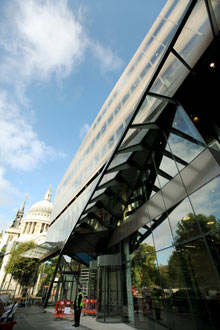One New Change is likely to be called many names in its lifetime, not all of them complimentary. An enormous shopping and office complex thumped down to the immediate east of St Paul's Cathedral in the City of London, it has been designed by French architect Jean Nouvel.
Though Nouvel's bright red Serpentine Gallery in Kensington Gardens made a colourful splash this summer, the architect is not particularly well known in Britain, and this is his first permanent building here. Some of his very best work – like the diaphanous Fondation Cartier and the mesmerising Institut du Monde Arabe with its hi-tech play on traditional Arabic designs, both in Paris – are truly captivating structures. However, One New Change is a very different beast.
The Prince of Wales, who believes the Luftwaffe did less damage to London than modern architects, has been sniping at One New Change since 2005, when he wrote to the developers, Land Securities, hoping to get Nouvel off the job and have him replaced by one of his "traditionalist" chappies. He failed, and One New Change looks like the kind of building that will cause controversy. The computer images on Nouvel's website, especially those showing it lit up at night, are seductive in a cinematic way. They make the building shine darkly, as if it were some unexpected meteorite or giant jewel glinting from the City streets. The reality, in the grey light of London, is far more sombre than this, if not exactly prosaic.
It's already known as the "stealth building" for two good reasons. First, this low, wide £500m behemoth, with its three floors of shops and five floors of offices, has muscled its way into the City while – remarkably – being all but invisible from just a few streets away. Second, its design – or, at least, its faceted facade or skin – really does have something of the look of a US Air Force Northrop Grumman B-2 Spirit, or stealth bomber, whose folded surface makes it virtually invisible to radar.

However, it's the colours of this bulky new arrival that truly startle. Instead of the military shades of grey one might expect, One New Change is sheathed in acres of largely opaque brown glass. For many centuries the Square Mile has been an enclave of largely white, grey and black buildings with discreet splashes of red brick or marble. Brown? No sir.
In fact, though Land Securities would never admit it – still less the team of architects led by Richard Rogers who chose Nouvel's design in an open competition held in 2003 – the role of One New Change may be to shock. Squeezing such a big building into the City has been a bit like pouring a heavyweight boxer into a city boy's suit. And, rather like a bespoke three-piece, while the exterior of the Nouvel building is essentially formal, its cruise-ship shiny, shop-lined interior is as flash as a loud silk lining.
The big idea is that the building appears to be a single block of material with passageways or "streets" carved through it, so that it feels like at least four separate, yet connected, buildings, turning around a central atrium. These "streets" are lined with shops and cafes, and have sloping walls. The biggest of them leads from the heart of One New Change to St Paul's Cathedral, framing studied views of Wren's enduring monument.
When you reach the atrium, a glass "panoramic" lift takes you up to a zig-zag, sixth-floor roof terrace. Whatever you make of the building as a whole, the experience of standing up here, so close to Wren's haunting dome, is undeniably moving and exciting. "You feel you can reach out and touch St Paul's," says Nouvel. It's true. Sitting here outside the rooftop cafe will be one of the most inspiring everyday experiences the City can offer.
There is little doubt that when it opens next Thursday, One New Change will be jam-packed with City workers and tourists. How can it go wrong? Nouvel sounds so very convincing when he says that "the design of One New Change is about enriching the City with a new sort of modernity. It is a contemporary building which will set up a dialogue with St Paul's and the neighbouring buildings. The design is calm and deferential to St Paul's and provides a unique opportunity to bring the public into the site."

The public will come anyway, such will be the allure of yet another branch of Topshop, H&M and Banana Republic, another outlet of Nando's and Eat; how can they resist a new Gordon Ramsay restaurant or Barbacoa, the latest culinary venture by Jamie Oliver and Adam Perry Lang? There are some independent shops, yet these are swamped by the big chains. Meanwhile, any new building on this site – good, bad or indifferent – would inevitably set up a dialogue with St Paul's. This mighty landmark can never be ignored, and the buildings around it must say something to their majestic neighbour if only to the effect that they don't care what it or anyone else feels about the way they look.
There goes the neighbourhood
Two big questions need to be asked about One New Change. One is whether the City of London should follow the path of every other British city centre; the other is whether Nouvel's stealthily bombastic design is the right neighbour for St Paul's. For me, it seems a little sad that the City is unable to follow its own star. Until very recently, it had retained its own special character. Here, a largely medieval street pattern adorned with fairytale names like Threadneedle Street and Pudding Lane is matched with secret, shoulder-wide alleys leading to quietly angelic churches, venerable pubs, ancient livery companies, and even the odd surviving independent shop with some half-remembered name, such as Shivelights and Shadowtackle or Dombey and Son. All this packed into the legendary Square Mile, between monuments to Mammon as traditional as the Bank of England and as a radical as the Gherkin, the up-and-coming Cheesegrater and all the other new towers with equally potty nicknames.
Certainly there have been fine places to shop in the City in the form of covered markets (such as Leadenhall Market, in the shadow of Richard Rogers's Lloyds Building), as well as the noble 1844 Royal Exchange alongside the Bank of England. Yet the City has remained aloof, or simply remote, from the wave of malls inundating Britain.
A cheeky wink to Wren

Until it was demolished to make way for the Nouvel building, St Paul's did have a good, and modest, neighbour in the guise of No 1 New Change, a Portland stone and red-brick office complex designed for the Bank of England by Victor Heal. Completed in 1960, this cautious and polite building was much mocked. And, yet, for all its conservative nature, Heal's building was a careful foil to St Paul's. Where Heal nodded politely to Wren, Nouvel winks at him cheekily as if saying: "Come on, grandpa; get down with the bling, and get shopping."
Assuming the Heal building had to go, I would never have recommended replacing it with the kind of Kentucky Fried Georgian buildings facing the north and west fronts of St Paul's in Paternoster Square. Creatures of the 1990s, these were – mostly – every bit as wrong here as One New Change is. Ultimately, St Paul's was best set off by the tight clusters of streets and buildings that stood almost within touching distance of its Portland stone walls until blitzed by the Luftwaffe. I suppose that today's big-shot developers could never make their money by creating a contemporary take on narrow streets and small independent shops and cafes; because of this, St Paul's was bound to be faced by a building as big as One New Change.
For me, though, it would make no difference whether or not One New Change had been designed by Frank Gehry or Alvaro Siza, or by today's equivalent (should they exist) of Wren or Hawksmoor. It just seems a shame to see the City of London go the way of all other cities. The heavily marketed idea that you can reach out and touch St Paul's from a funky new "stealth" shopping mall is not reward enough for robbing the City of what passes for its soul.

















